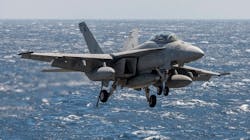Navy taps Boeing to provide 136 military avionics mission computer systems for F/A-18 combat aircraft
PATUXENT RIVER NAS, Md. – Military avionics experts at the Boeing Co. will provide 136 new Advanced Mission Computer (AMC) systems for the U.S. Navy F/A-18E/F Super Hornet and EA-18G Growler combat aircraft under terms of a $51.6 million contract announced Friday.
Officials of the Naval Air Systems Command at Patuxent River Naval Air Station, Md., are asking the Boeing Defense, Space & Security segment in St. Louis to provide 136 AMC systems, which are designed and manufactured by the General Dynamics Corp. Mission Systems segment in Bloomington, Minn.
The latest version of the F/A-18 mission computer is the AMC Type 4, which first was flight tested in 2012. Type 4 AMC increases computing power and accelerates image and mission processing functions, Boeing officials say.
Those advances will support new systems and future systems aboard the aircraft, including a distributed targeting system, infrared search and track, and a new high-definition touch-screen display.
Related: General Dynamics wins $16.3 million contract for mission computers on Navy EA-18G EW jets
The AMC is the nerve center of the Navy Super Hornet. The commercial off-the-shelf (COTS)-based, open-systems architecture product is configurable to many operating environments.
The flight and mission computer is designed to handle mission processing; sensor processing; display processing; stores management; and information management.
The AMC is a rugged embedded computer that performs general-purpose, I/O, video, voice, and graphics processing. Communication is over several buses, including 1553, Fibre Optic Fibre Channel, and Local PCI.
Single-board computers and other modules in the AMC fit in an industry standard 6U VME backplane, and the I/O configuration may be tailored with PMC mezzanine card (PMC) modules. An Ethernet interface supports software development and system maintenance.
The AMC's core system software (CSS) is a real-time operating system with embedded system software, application program interface, and diagnostic software set for the AMC. The computer's I/O includes MIL-STD-1553 drivers, Fibre Channel drivers, VMEbus drivers, and discrete and serial I/O drivers.
On this contract Boeing will do the work in St. Louis, and should be finished by February 2022. For more information contact Boeing Defense, Space & Security online at www.boeing.com, General Dynamics Mission Systems at https://gdmissionsystems.com, or Naval Air Systems Command at www.navair.navy.mil.

John Keller | Editor-in-Chief
John Keller is the Editor-in-Chief, Military & Aerospace Electronics Magazine--provides extensive coverage and analysis of enabling electronics and optoelectronic technologies in military, space and commercial aviation applications. John has been a member of the Military & Aerospace Electronics staff since 1989 and chief editor since 1995.

